Estimate of Hydrofluorocarbon Emissions for 2012-16 in the Yangtze River Delta, China
Jingjiao PU, Honghui XU, Bo YAO, Yan YU, Yujun JIANG,, Qianli MA, and Liqu CHEN
1Zhejiang Meteorological Science Institute, Hangzhou 310008, China
2Meteorological Observation Center of China Meteorological Administration, Beijing 100081, China
3Zhejiang Lin'an Atmospheric Background National Observation and Research Station, Hangzhou 311307, China
ABSTRACT
Key words: hydrofluorocarbons, emissions, Yangtze River Delta, tracer ratio method
1. Introduction
Hydrofluorocarbons (HFCs), since containing no ozonedepleting chlorine or bromine, have been widely used in China as substitutes for ozone-depleting substances (ODSs),the production and use of which are being phased out under the Montreal Protocol. However, HFCs are also long-lived potent greenhouse gases with global warming potentials(GWPs) as high as ozone-depleting chlorofluorocarbons(CFCs) and halons (IPCC, 2005). Consequently, HFCs are regulated under both the 1997 Kyoto Protocol and the 2016 Kigali Amendment to the Montreal Protocol (WMO, 2018).According to the Advanced Global Atmospheric Gases Experiment (AGAGE) network, the global surface mean mixing ratios of HFCs in the atmosphere increased from 2012 to 2016 by average rates of 1.6 parts per trillion (ppt) yr-1for HFC-32 (CH2F2), 2.1 ppt yr-1for HFC-125 (CHF2CF3), 5.6 ppt yr-1for HFC-134a (CH2FCF3), and 1.5 ppt yr-1for HFC-143a (CH3CF3), which were larger than the mean increases respectively reported for 2008—12 (WMO, 2018).As emission sources of HFCs are mainly from industrial sectors, such as foam blowing, household/commercial refrigeration, fire extinguishing, etc. (Fang et al., 2018), the increased mixing ratios of HFCs in the atmosphere can be attributed to anthropogenic emissions (Forster et al., 2007).Therefore, many recent studies have focused on estimating anthropogenic HFC emissions.
Three methods are widely used to estimate the emissions of halocarbons including HFCs. The bottom-up method is based on the data of production and consumption from various sectors, as well as empirical emission factors(IPCC, 2005). China’s halocarbon emission inventories have been reported by using this approach, e.g., China’s historical emissions of ODSs until 2014 (Fang et al., 2018),HFC emissions in China for 2005—13 (Fang et al., 2016),China’s halocarbon emissions for 1995—2004 (Wan et al.,2009), and HFC-410A emissions from the room air-conditioning sector in China for 2006—17 (Liu et al., 2019). The topdown method combines atmospheric measurements and inverse models to simulate the potential sources to the measurement sites and geographic distribution of emission intensities. This approach has been used in estimating the HCFC and HFC emissions in East Asia for the year 2008 (Stohl et al., 2010), CFC-11 emissions from eastern Asia for 2008—17 (Rigby et al., 2019), and HFC and HCFC emissions from China for 2011—17 (Fang et al., 2019; Yao et al.,2019). The third method is the tracer ratio method, which is based on the ratios of measured halocarbons to selected tracers with known emissions, such as CO or HCFC-22. It has been used to infer halocarbon emissions in the Pearl River Delta (PRD) (Shao et al., 2011; Wu et al., 2014),HFC and PFC emissions from the North China Plain (Yao et al., 2012), and anthropogenic halocarbon emissions from China (Fang et al., 2012a).
The Yangtze River Delta (YRD) is a fast-growing region in China with rapid urbanization and industrialization. The region accounted for 16.1% of China’s population and 23.5% of its Gross Domestic Product (GDP) from 2012 to 2016 (National Bureau of Statistics of China, 2013a,2014a, 2015a, 2016a, 2017a). Rapid economic growth has been partly driven by the expanding manufacturing sector,including the fluorine chemical industry, production of electronics, air conditioners, refrigerators and automobiles,which would result in a large amount of HFC emissions. Previous studies have reported that HFC emissions from China grew rapidly since 2005 due to the phase-out of ODSs, and China has become a major producer and consumer of HFCs around the world (Zhang and Wang, 2014; Fang et al.,2016). Mixing ratios of HFCs have been reported in China,as well as in a few specific regions in China, including the YRD (Barletta et al., 2006; Fang et al., 2012b; Zhang et al.,2017). However, studies on China’s HFC emissions or their emission sources have mainly been conducted in the PRD(Wu et al., 2014), Yellow River Delta (Zheng et al., 2019),North China Plain (Yao et al., 2012), and the entire country(Yao et al., 2012, 2019), while few studies have been conducted in the YRD, an area that might contribute significantly to China’s total HFC emissions (Li et al., 2014). In this study, weekly flask measurements for 10 HFCs (HFC-23,HFC-32, HFC-125, HFC-134a, HFC-143a, HFC-152a,HFC-227ea, HFC-236fa, HFC-245fa and HFC-365mfc)were performed at Lin’an Regional Background (LAN) station in the YRD over the period 2012—16. The correlation between HFC and CO enhanced mixing ratios was analyzed and HFC emissions in the YRD were further inferred by the tracer ratio method. The results were compared with those derived by both the inverse modeling method (FLEXPART-model-based Bayesian inverse modeling) and bottom-up method. Finally, the contribution of HFCs in terms of CO2-equivalent emissions from the YRD to the national total was evaluated to inform understanding of the regional significance.
2. Methods
2.1. Sampling site
The sampling site was at LAN station [(30.30°N,119.73°E), 138.6MSL, as shown in Fig. 1], which is located in the south of the YRD region and is about 60 km to the west of Hangzhou and about 195 km to the southwest of Shanghai. The station is well vegetated, surrounded by hilly lands, forest and farmland. The prevailing wind directions are northeasterly and southwesterly (seen in Fig. A1 in Appendix), with distinct meteorological characteristics of subtropical monsoon climate. According to previous studies,LAN station can represent the background circumstances well in the YRD region (Yan et al., 2012; Feng et al., 2015;Deng et al., 2018).
The areas that might contribute significant emissions to LAN station were identified by backward trajectory calculations using the Lagrangian particle dispersion model FLEXPART (V9.01; Stohl et al., 2005). The model was driven by ECMWF (European Centre for Medium range Weather Forecasts) Operational Analysis Data, with a global resolution of 1° × 1° and regional resolution of 0.2° × 0.2° over eastern China. Ten-day air mass backward trajectories were calculated at the sampling time. The derived source receptor relationships (SRRs) (Seibert and Frank, 2004) demonstrated the sensitivity of the mixing ratio observations at LAN to emissions on the grid. The total SRR calculated for HFC pollution events at LAN station from 2012 to 2016 revealed that the potential source area with significant influence was concentrated in four provinces of the YRD (Anhui, Jiangsu,Shanghai and Zhejiang).
2.2. Experimental method
The sampling time was 1400—1430 LST, when the atmosphere was well mixed, every Wednesday, over the period 2012—16. The ambient air was drawn from the top of a 50-m-high tower and pressurized into two 3-L canisters that were connected in series. The air samples were shipped to the Greenhouse Gases Laboratory of the Meteorological Observation Center of the China Meteorological Administration (MOC/CMA) in Beijing, where the mixing ratios of the 10 HFCs (HFC-23, HFC-32, HFC-125, HFC-134a, HFC-143a, HFC-152a, HFC-227ea, HFC-236fa, HFC-245fa and HFC-365mfc) were measured by the Medusa GC-MS technique developed by AGAGE. The relative measurement precisions were typically < 3% for HFC-365mfc and < 1% for other HFCs. The system was calibrated by standards traced to AGAGE reference standards and the HFC mixing ratios were reported on the primary calibration scales developed at the Scripps Institution of Oceanography. More detailed information on the sampling, instruments and quality control was provided in previous studies (Zhang et al., 2017;Yao et al., 2019).
CO was observed in-situ by a cavity ring-down spectroscopy (CRDS) analyzer (G2401, Picarro Inc., Califonia,USA). The air sample was collected from the same inlet as the HFC samples, and delivered to the analyzer by a membrane pump. After being filtered, the air samples were dried to a dew point of approximately -60°C. The precision of CO measured with this technique is < 2 parts per billion(ppb). The system was calibrated by standard gases that were traceable to WMO/GAW primary standards every 6 h.The observing method was described in detail in Fang et al.(2013). The 5-min average CO concentration closest to the HFC sampling time was chosen, and the time interval between the corresponding samples of the two observations should be no more than 1 h.
2.3. Data analysis
The mixing ratios of HFCs were distinguished as“baseline level” and “pollution level” by sequentially applying the “robust extraction of baseline signal” filter (REBS;Ruckstuhl et al., 2012) and a background wind sector method. Firstly, the REBS technique was applied to filter the observation data iteratively so as to fit a local regression curve, and the outliers outside the 1σ range around the current baseline were excluded iteratively until all the data were within the ± 1σ range of the baseline, which could be flagged as “background values”. Secondly, the pollution values were identified by a meteorological data filter, when the airflow came from polluted wind sectors. The background and polluted wind sectors were defined by local pollution sources and the characteristics of other tracers such as CO(Zhou et al., 2003, 2004). The filtered results can be seen in Fig. A2. Finally, the mixing ratio enhancements of HFCs were determined by the absolute value of the polluted mixing ratios minus the background mixing ratios. Considering the lack of background values at LAN, where anthropogenic emissions render significant influence, the background mixing ratios of HFCs in this study were employed via the measurements at Shangri-la (XGL) station[(28°01′N, 99°26′E), 3580.0 MSL], with similar latitude and located far away from human habitat. The air was sampled at XGL with the same method and analyzed with the same instrument type in the lab at MOC/CMA (Zhang et al.,2017; Yao et al., 2019). The background mixing ratio at XGL observed on the same date as that at LAN was chosen first, and if it was missing, the monthly average at XGL was used instead. In-situ CO concentrations were filtered by the REBS filter method (Ruckstuhl et al., 2012).
2.4. Emissions estimation
This study adopted the tracer ratio method, which has been widely used in estimating halocarbon emissions. CO was chosen as a tracer since its anthropogenic emissions could be better known than HCFC-22. Many previous studies have focused on CO emissions (Ohara et al., 2007;Zhang et al., 2009; Li et al., 2017; Zheng et al., 2018a,2018b). The CO emissions of the YRD (including Shanghai, Zhejiang, Jiangsu and Anhui provinces) were derived from the CO anthropogenic emissions inventory of MEIC(Multi-resolution Emissions Inventory for China) based on the years 2010 and 2016 (Li et al., 2017), with values of 22.4 and 19.6 Tg yr-1, respectively. The interannual trend of CO emissions in the YRD over the period 2012—15 was determined according to a -2% yr-1decrease in total Chinese CO emissions (Zheng et al., 2018a, 2018b) and the annual growth rate of smoke and dust emissions from the YRD (National Bureau of Statistics of China, 2013a, 2014a,2015a, 2016a, 2017a), resulting in annual CO emissions of 23.1, 24.5, 35.9 and 30.6 Tg yr-1from 2012 to 2015. Thus,the average CO emissions rate of the YRD was about 26.7 Tg yr-1over the period 2012—16. The uncertainty of CO emissions was assumed to be 35%, as reported in previous studies (Zhang et al., 2009; Li et al., 2017).
The correlations of mixing ratio enhancements between specific HFCs and CO were analyzed in order to assess the applicability of the tracer ratio method to estimate HFC emissions, because a reliable tracer should have significant correlation with most other compounds (Wang et al., 2014). The emissions of the target HFC, Ex(Gg yr-1), can be calculated by its mixing ratio enhancement (ΔCx) and the mixing ratio enhancement of CO (ΔCCO) as follows:
where Exand ECOrepresent the total emissions of target HFC and that of CO, respectively. Mxand MCOare the molecular weight of the target HFC and CO, respectively.The uncertainty of the emissions estimate was calculated by error propagation, as below:

where b is the mixing ratio enhancement slope; and σband σEcoare the uncertainties of b and ECO, respectively. Finally,the HFC CO2-equivalent emissions were calculated using the emissions of each HFC multiplied by their 100-yr GWPs (Forster et al., 2007), to evaluate the contribution of the greenhouse effect of HFC emissions in the YRD to that of China.
3. Results and discussion
3.1. HFC mixing ratios
The mixing ratios of HFCs at LAN from 4 January 2012 to 28 December 2016 are illustrated in Table 1 (except for the observation of HFC-365mfc, which started from 6 August 2014), and five-year time series for HFC mixing ratios are presented in Fig. A2. The background mixing ratios of both HFC-23 and HFC-32 accounted for less than 5%, while the background values of HFC-125, HFC-134a,HFC-152a and HFC-245fa took percentages of 10%—20%.Therefore, the background mixing ratios of all 10 HFCs at XGL were instead considered. The relative errors between the background mixing ratios of HFCs at LAN and at XGL were 3.8% (HFC-23), 23.0% (HFC-32), 3.9% (HFC-125),5.2% (HFC-134a), 6.0% (HFC-143a), 31.8% (HFC-152a),0.0% (HFC-227ea), 7.1% (HFC-236fa), 10.3% (HFC-245fa) and 10.6% (HFC-365mfc), which could be mainly explained by the asynchronous sampling time of the background samples at these two stations. Also, they were muchlower than the relative differences between background mixing ratios and pollution mixing ratios of HFCs at LAN,except for HFC-152a, for the mixing ratio of HFC-152a probably has a non-negligible latitudinal gradient (Zhang et al.,2017). Overall, it was feasible to employ the background mixing ratios of HFCs at XGL to represent those at LAN to calculate the mixing ratio enhancements.

Table 1. Mixing ratios of HFCs measured at LAN and XGL during 2012—16.
The pollution mixing ratios of HFCs at LAN were much higher than the background values observed at XGL over the period 2012—16. The enhancements between mixing ratios measured at these two stations were 30%—50%(HFC-23, HFC-134a, HFC-143a, HFC-245fa and HFC-365mfc), 61% (HFC-125), 87% (HFC-227ea), 102% (HFC-152a), 179% (HFC-32) and 931% (HFC-236fa).
3.2. Interspecies correlations of HFCs and CO
The interspecies correlations of enhanced mixing ratios of the 10 HFCs versus CO are shown in Table 2 and Fig. 2.HFC-23, HFC-32, HFC-125, HFC-152a and HFC-245fa presented significant correlations with the tracer CO (p<0.001), showing Pearson correlation coefficients larger than 0.31. HFC-134a and HFC-227ea also displayed significant but slightly worse correlations (p <0.025), with the correlation coefficients between 0.22 and 0.23. The enhanced mixing ratios of HFC-143a, HFC-236fa and HFC-365mfc did not significantly correlate with those of CO, which might be partly explained by less polluted samples compared to other HFCs (Table 2), and China’s emissions of these three HFCs were relatively small among all HFCs in previous studies(Kim et al., 2010; Yao et al., 2019). Therefore, the emissions of HFC-143a, HFC-236fa and HFC-365mfc are not discussed in this paper.
3.3. HFC emissions of the YRD
As listed in Table 3, the estimated total emissions of HFCs in the YRD from 2012 to 2016 were 2.4±1.4 Gg yr-1for HFC-23, 2.8±1.2 Gg yr-1for HFC-32, 2.2±1.2 Gg yr-1for HFC-125, 4.8±4.8 Gg yr-1for HFC-134a, 0.9±0.6 Gg yr-1for HFC-152a, 0.3±0.3 Gg yr-1for HFC-227ea and 0.3±0.2 Gg yr-1for HFC-245fa, respectively. As shown in Fig. 3,among these seven HFCs, HFC-134a, HFC-32, HFC-23 and HFC-125 were the four main HFCs in the YRD, with propor-tions of 35%, 21%, 18% and 16%, respectively, while the total emissions of the other three HFCs shared less than 11%.

Table 2. Pearson correlation coefficient (R) and regression slope (S) of mixing ratio enhancements between HFCs and CO, with 95%confidence bounds, over the period 2012—16.
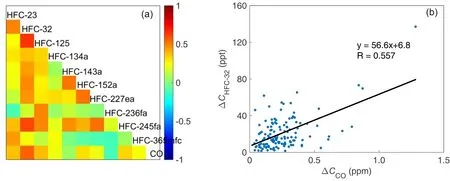
Fig. 2. Correlation coefficient matrix between observed CO and HFC mixing ratio enhancements (a), and regression plots of mixing ratio enhancement of HFC-32 and CO as an example (b).
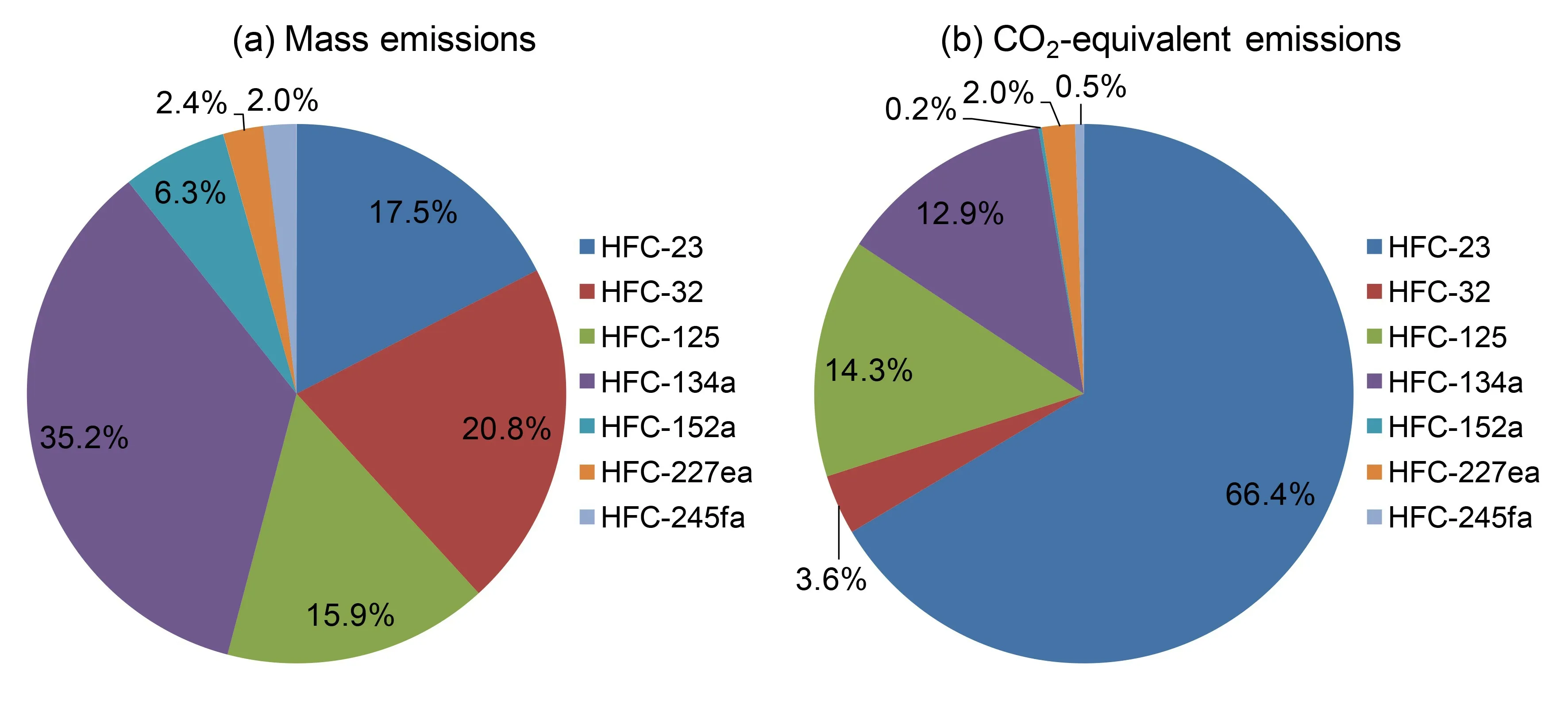
Fig. 3. HFC emission proportions in the YRD over the period 2012—16: (a) mass emissions; (b) CO2-equivalent emissions.
In terms of CO2-equivalent emissions, HFC-23 contributed about two thirds to the total CO2-equivalent emissions due to its high GWP (GWP100=14800) among all 10 of the HFCs in this study. The contribution of HFC-125 or HFC-134a to total CO2-equivalent HFC emissions exceeded 10%,and HFC-32 emissions contributed 3.6%, while the other three HFCs in total contributed less than 3%. Thus, the major HFC compounds in the YRD were HFC-134a, HFC-23, HFC-125 and HFC-32, with both largest mass emissions and CO2-equivalent emissions, and HFC-23 was the primary HFC considering CO2-equivalent emissions. The total CO2-equivalent emissions of HFCs reached 53 Gg yr-1in the YRD, accounting for 2.3% of the CO2emissions without landuse, land-use change and forestry in this region(CCGGWP, 2019).
HFC emissions in this study were also compared with results reported by previous studies using the bottom-up method, as listed in Table 3. The HFC emissions of the whole of China are listed because studies of the YRD are limited. HFC-23 and HFC-134a emissions in this study and those using the bottom-up method (CCGGWP, 2019)differed relatively little, at 4.2% and 14.5%, respectively.HFC-23 is mainly emitted as a byproduct of HCFC-22 production (Miller et al., 2010). There are nine fluorine chemistry plants producing HCFC-22 in the YRD, of which three are located in Jiangsu Province (contributing 18% of HFC-23 emissions) and six in Zhejiang Province (contributing 82%of HFC-23 emissions). HFC-134a is mainly used as a substitute for CFC-12 in the automobile air-conditioning sector(Hu et al., 2010). Over the period 2012—16, the HFC-134a emissions in the YRD derived from the tracer ratio method comprised 18.6% of those in China by the inverse modeling method, which was consistent with the percentage(approximately 20%) of vehicle numbers in the YRD of the whole country (National Bureau of Statistics of China,2013a, 2014a, 2015a, 2016a, 2017a). There were understandable differences in HFC-125 and HFC-32 emissions between this study and those using the bottom-up method(CCGGWP, 2019) because only their consumption as mixed-blend HFC-410A from the room air-conditioning sector was considered by the bottom-up method. Besides their primary usage, HFC-125 and HFC-32 are also used as R-32 or other mixed blends, such as R-404a and R-507a (Li et al.,2011). The ratios of HFC-410A emissions (sum of HFC-32 emissions and HFC-125 emissions) by the bottom-up method (CCGGWP, 2019) to the sum of HFC-32 and HFC-125 emissions by the tracer ratio method or top-down method were all around 0.5, both in the YRD and at the national scale, indicating that half of HFC-32 and HFC-125 might be used as HFC-410A in the room air-conditioning sector in China.
It should be noted that up-to-date HFC emissions in China have been reported by a few different studies in the past two years (MEE, 2018; CCGGWP, 2019; Yao et al.,2019). However, there were significantly large differences(as large as 2 to 90 times, depending on specific HFC species) among the different studies, which could hardly be explained by their different time scales. Further studies are needed to reduce these discrepancies.
3.4. The YRD’s HFC emissions contribution to China
The proportion of HFC emissions in the YRD to national totals reflects the regional significance. Here, the emissions using the top-down method for the same period(Yao et al., 2019) and HFC-23 emissions in 2015 by CCGGWP (2019) were chosen to represent national levels.Therefore, the HFC emissions in the YRD counted for 46%(HFC-23), 38% (HFC-32), 23% (HFC-125), 19% (HFC-134a), 18% (HFC-152a), 36% (HFC-227ea) and 27%(HFC-245fa) of national totals. The total CO2-equivalent emissions of these seven HFCs in the YRD contributed 34%of the total HFC emissions in China. In comparison with previous studies that were carried out in other regions of China,the HFC-134a in the PRD accounted for only about 8% of national total emissions in 2010 (Wu et al., 2014), and the per capita HFC-134a emissions rate was 12.5 g yr-1, which is much lower than that in the YRD at 18.7 g yr-1. Therefore, the YRD constitutes a significant emissions source of HFCs in China.
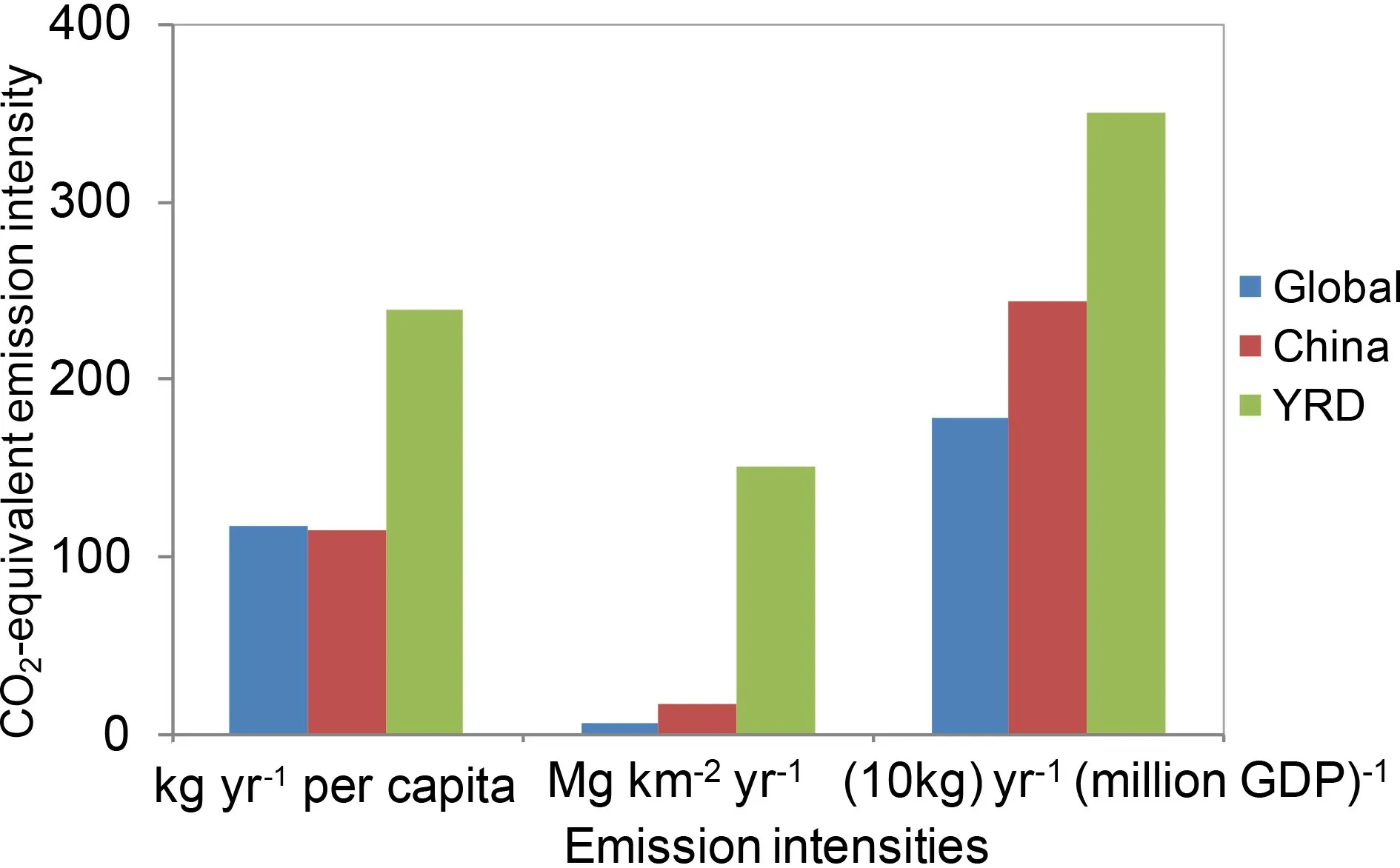
Fig. 4. Comparison of total HFC CO2-equivalent emission intensities of the YRD, China and global levels from 2012 to 2016. National CO2-equivalent emissions of HFC-23 were derived from the bottom-up method (CCGGWP, 2019), and other HFC emissions were from the inverse modeling method(Yao et al., 2019). Global total CO2-equivalent emissions were based on emissions derived from observations at remote AGAGE stations (Rigby et al., 2014; Engel et al., 2018).
The CO2-equivalent emission intensities of HFCs are illustrated in Fig. 4. Here, global total CO2-equivalent emissions were based on emissions derived from observations at remote AGAGE stations (Rigby et al., 2014; Engel et al.,2018), and the global population and GDP were derived from the International Statistical Yearbook (National Bureau of Statistics of China, 2013b, 2014b, 2015b, 2016b,2017b). The national population and GDP data were from the China Statistical Yearbook (National Bureau of Statistics of China, 2013a, 2014a, 2015a, 2016a, 2017a). Compared with either the national or global emissions intensity,the YRD displayed as a higher HFC emitter. The per capita HFC CO2-equivalent emissions intensity of the YRD was nearly twice the national or global levels, at 240 kg per capita per year. In terms of emissions per unit area, the emissions intensity of the YRD was about 24 times the global value and 8 times the national value, amounting to more than 150 Mg km-2yr-1. The emissions rate per million GDP in Chinese Yuan (CNY) was 3500 kg yr-1, twice the global value. In conclusion, the emissions intensity of HFCs in the YRD was notably high, whether in terms of per capita or per unit area or per unit GDP. It should be noted that HFC-23 emissions in the YRD contributed around two thirds to total HFC emissions in the YRD, or more than 1/5 to the national HFC emissions, in terms of CO2-equivalent.Hence, if HFC-23 emissions were totally eliminated, the emissions intensity of the YRD would be lower than national and global levels, and thus HFC-23 is the key HFC species when considering the mitigation potential of HFCs in the YRD, or even in China as a whole.
4. Conclusions
Based on co-located atmospheric measurements of 10 HFCs and CO at LAN in the YRD from 2012 to 2016, significant correlations were found between the enhanced mixing ratio of CO and those of seven HFCs, which were HFC-23, HFC-32, HFC-125, HFC-134a, HFC-152a, HFC-227ea and HFC-245fa. The emissions of these HFCs were estimated by the tracer ratio method. Among these seven HFCs,HFC-134a, HFC-23, HFC-32 and HFC-125 contributed more than 89% of the total emissions, while in terms of CO2-equivalent emissions, HFC-23 contributed approximately two thirds of all HFCs.
HFC-23 and HFC-134a emissions in this study were estimated to be quite close to those using the bottom-up method. However, there were large discrepancies among different studies in terms of national-scale estimation.
The total HFC CO2-equivalent emissions of the YRD contributed 34% of the national total, and the HFC emissions intensity of the YRD was much larger than the national or global level in terms of per capita, or per unit area, or per unit GDP. Therefore, the YRD region is a significant source area for HFC emissions in China, indicating the considerable mitigation potential that could be achieved by regulating HFC-23 in the YRD region.
Acknowledgements. This study was supported by the National Natural Science Foundation of China (Grant Nos.41575114 and 41730103), the Zhejiang Provincial Natural Science Foundation (Grant No. LY19D050002) and the Meteorological Science and Technology Program of Zhejiang Province(Grant No. 2019ZD12). We thank the station personnel who have supported canister sampling at XGL. We also thank the AGAGE network for its technical assistance and the Scripps Institution of Oceanography for help with the technique transfer, processing software and calibration standards.
APPENDIX
TIME SERIES of HFC MIXING RATIOS at LAN
Figure A2 shows the time series of the HFC mixing ratios observed at LAN from 2012 to 2016. The progressive increase of eight HFC (HFC-23, HFC-32, HFC-125,HFC-134a, HFC-143a, HFC-227ea, HFC-245fa, and HFC-365mfc) mixing ratios at LAN can be seen, while the annual average mixing ratios of HFC-152a and HFC-236fa fluctuated without rapid increase at LAN from 2012 to 2016. Compared to the annual mean growth rates of HFCs observed at SDZ station in the North China Plain from 2010 to 2011 (Yao,et al, 2012), the values at LAN were much higher for HFC-23, HFC-32, HFC-125, and HFC-134a, but not HFC-152a.
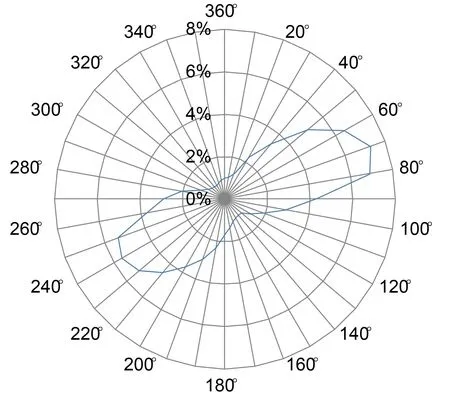
Fig. A1. Wind rose at LAN station from January 2012 to December 2016 based on hourly data.
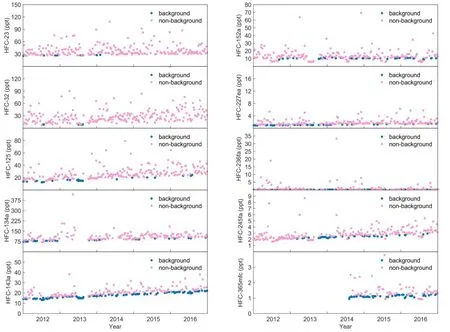
Fig. A2. Time series of HFC mixing ratios at LAN station from January 2012 to December 2016.
 Advances in Atmospheric Sciences2020年6期
Advances in Atmospheric Sciences2020年6期
- Advances in Atmospheric Sciences的其它文章
- Comparison of Ozone Fluxes over a Maize Field Measured with Gradient Methods and the Eddy Covariance Technique
- Deriving Temporal and Vertical Distributions of Methane in Xianghe Using Ground-based Fourier Transform Infrared and Gas-analyzer Measurements
- Direct Observations of Atmospheric Transport and Stratosphere-Troposphere Exchange from High-Precision Carbon Dioxide and Carbon Monoxide Profile Measurements
- An Observing System Simulation Experiment to Assess the Potential Impact of a Virtual Mobile Communication Tower-based Observation Network on Weather Forecasting Accuracy in China. Part 1: Weather Stations with a Typical Mobile Tower Height of 40 m
- On the Epochal Variability in the Frequency of Cyclones during the Pre-Onset and Onset Phases of the Monsoon over the North Indian Ocean
- Relationship between Solar Wind-Magnetosphere Energy and Eurasian Winter Cold Events
